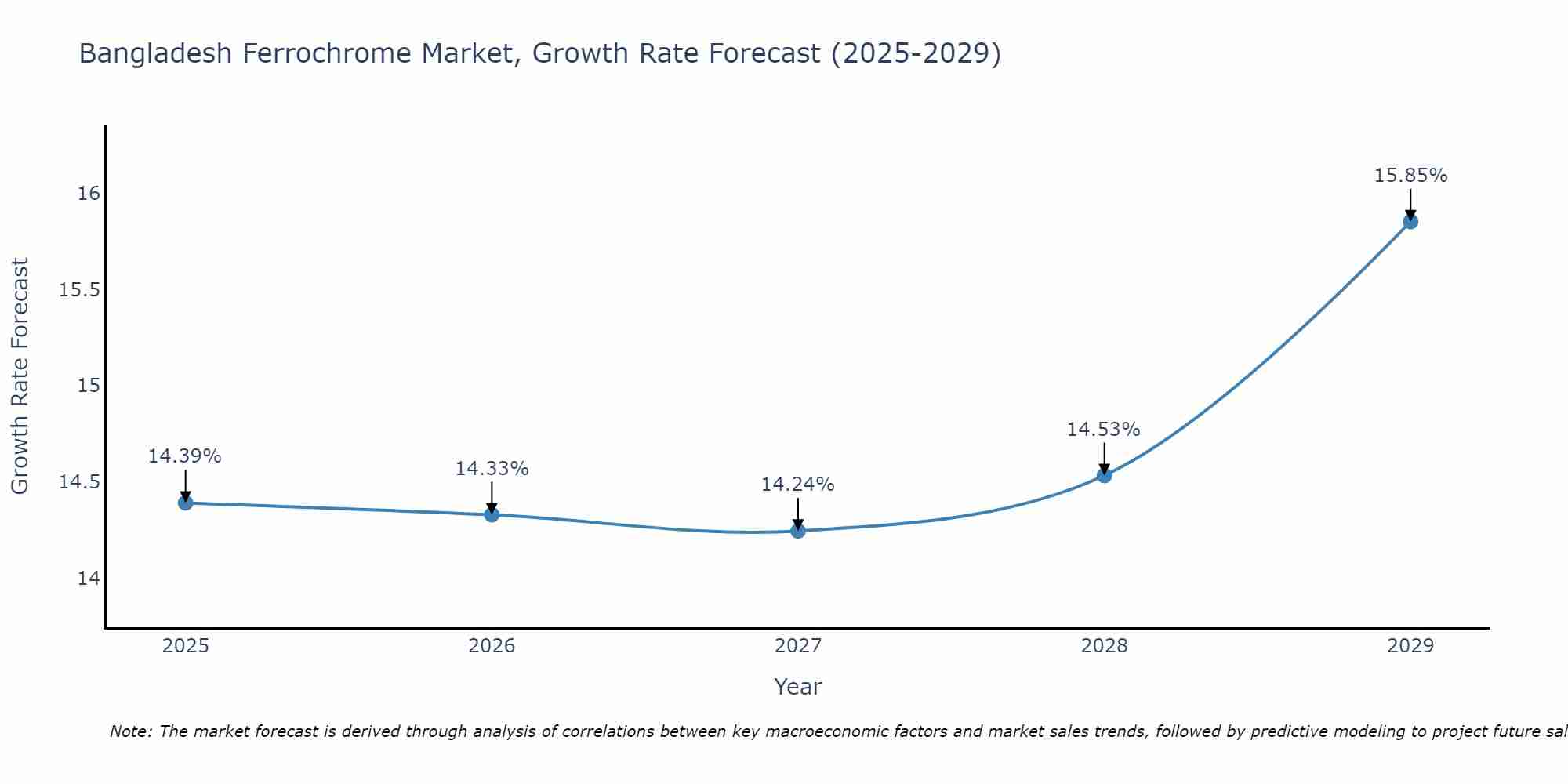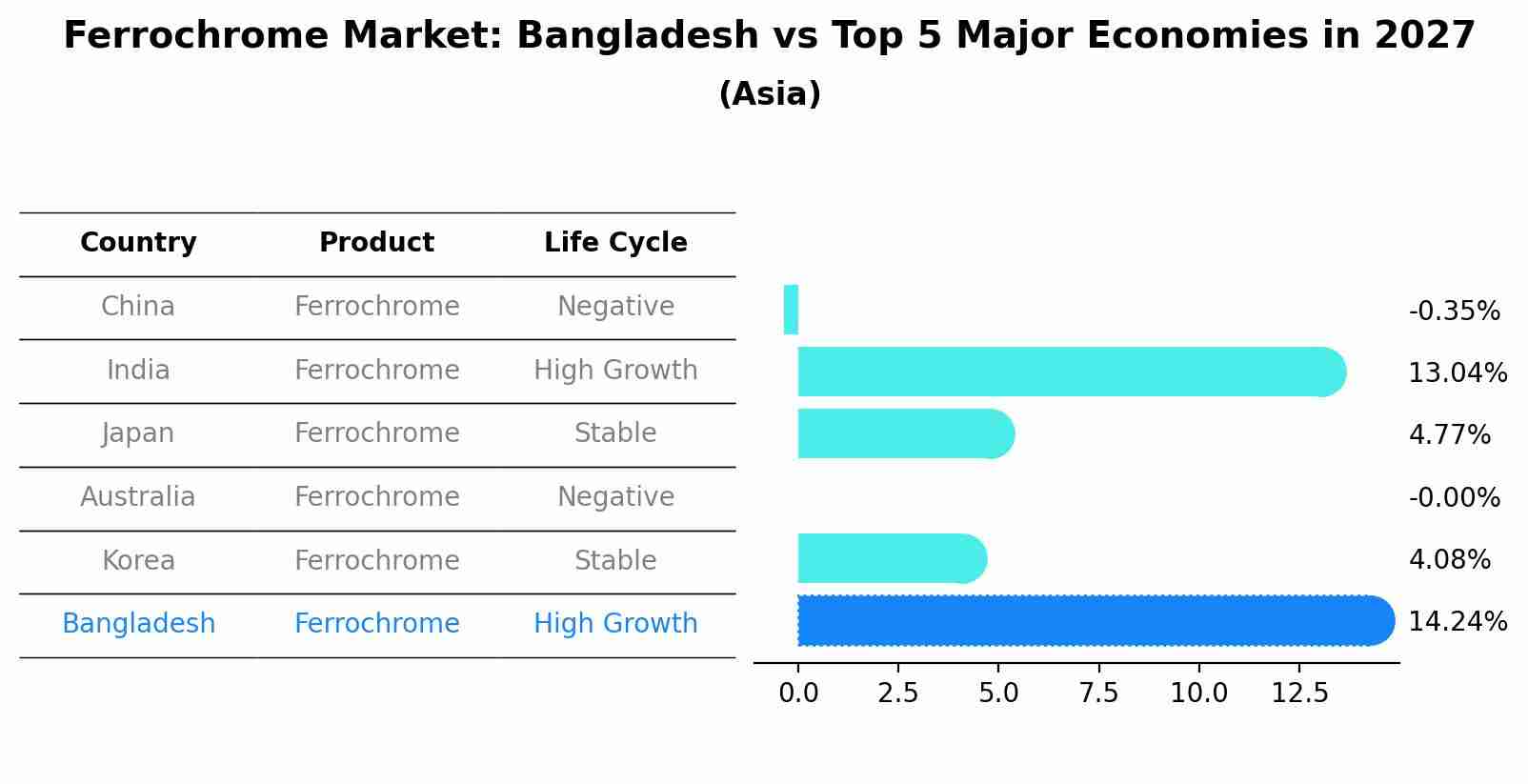Bangladesh Ferrochrome Market (2025-2031) Outlook | Companies, Trends, Size, Industry, Value, Forecast, Share, Growth, Revenue & Analysis
| Product Code: ETC092331 | Publication Date: Jun 2021 | Updated Date: Jun 2025 | Product Type: Report | |
| Publisher: 6Wresearch | Author: Sachin Kumar Rai | No. of Pages: 70 | No. of Figures: 35 | No. of Tables: 5 |
Bangladesh Ferrochrome Market Size Growth Rate
The Bangladesh Ferrochrome Market is projected to witness mixed growth rate patterns during 2025 to 2029. Commencing at 14.39% in 2025, growth builds up to 15.85% by 2029.

Ferrochrome Market: Bangladesh vs Top 5 Major Economies in 2027 (Asia)
Bangladesh's Ferrochrome market is anticipated to experience a high growth rate of 14.24% by 2027, reflecting trends observed in the largest economy China, followed by India, Japan, Australia and South Korea.

Bangladesh Ferrochrome Market Overview
The Bangladesh Ferrochrome market is experiencing steady growth driven by the increasing demand from the stainless steel industry. Ferrochrome, an essential alloying element in stainless steel production, is witnessing a rise in consumption as infrastructure and construction projects fuel the need for stainless steel products in the country. The market is also benefiting from the expanding manufacturing sector and the government`s focus on industrial development. Market players are focusing on enhancing production capacity and improving product quality to meet the growing demand. However, challenges such as fluctuating raw material prices and environmental regulations pose a threat to market growth. Overall, the Bangladesh Ferrochrome market presents opportunities for both domestic producers and international players looking to capitalize on the country`s growing stainless steel industry.
Bangladesh Ferrochrome Market Trends
The Bangladesh Ferrochrome market is experiencing growth due to increasing demand from the stainless steel industry and infrastructure development projects. The market is witnessing a trend towards the use of high carbon ferrochrome for its superior properties in terms of strength and corrosion resistance. Additionally, there is a growing focus on sustainability and environmental concerns, leading to a shift towards the production of ferrochrome using cleaner technologies. The market is also influenced by fluctuations in global prices of chromium ore, impacting the overall cost of production and pricing strategies of local manufacturers. Overall, the Bangladesh Ferrochrome market is poised for steady growth as the country continues to invest in industrial and infrastructure projects, driving the demand for stainless steel and related products.
Bangladesh Ferrochrome Market Challenges
In the Bangladesh Ferrochrome market, some key challenges include fluctuating raw material prices, particularly for chromite ore sourced from international markets. This can impact production costs and overall profitability for local ferrochrome manufacturers. Additionally, power outages and supply chain disruptions pose operational challenges for the industry. Market competition, both domestically and from international suppliers, also presents a hurdle for local ferrochrome producers in terms of pricing and market share. Furthermore, environmental regulations and sustainability concerns are becoming increasingly important, leading to additional compliance and investment requirements. Overall, navigating these challenges requires strategic planning, efficient resource management, and a focus on innovation to stay competitive in the Bangladesh Ferrochrome market.
Bangladesh Ferrochrome Market Investment Opportunities
In the Bangladesh Ferrochrome market, there are several investment opportunities to consider. One potential opportunity is investing in the production of ferrochrome itself, as the demand for this alloy is expected to increase with the growth of the stainless steel industry in the country. Additionally, investing in the mining and extraction of chrome ore, which is a key raw material for ferrochrome production, could also be lucrative. Another avenue for investment is in technology and equipment for ferrochrome production facilities to improve efficiency and reduce costs. Furthermore, investing in research and development for innovative ferrochrome production processes or exploring export opportunities for ferrochrome could provide substantial returns in the evolving Bangladesh market.
Bangladesh Ferrochrome Market Government Policy
The Bangladesh government has implemented policies to promote the growth of the Ferrochrome market in the country. These policies include offering tax incentives and subsidies to attract foreign investment in the sector, as well as providing support for research and development initiatives to enhance the competitiveness of local Ferrochrome producers. Additionally, the government has imposed regulations to ensure environmental sustainability in Ferrochrome production processes, focusing on reducing emissions and promoting energy efficiency. Overall, these policies aim to drive the expansion of the Ferrochrome market in Bangladesh, create employment opportunities, and contribute to the country`s industrial development while maintaining environmental sustainability.
Bangladesh Ferrochrome Market Future Outlook
The future outlook for the Bangladesh Ferrochrome Market appears promising, with steady growth anticipated in the coming years. Factors such as increasing infrastructure development, rising industrialization, and growing demand from the stainless steel industry are expected to drive the market forward. Additionally, the government`s focus on promoting the manufacturing sector and attracting foreign investment could further boost the demand for ferrochrome in Bangladesh. However, challenges such as fluctuating raw material prices and global market dynamics may impact the market in the short term. Overall, a positive trajectory is forecasted for the Bangladesh Ferrochrome Market, with opportunities for market players to capitalize on the country`s growing industrial base and infrastructure projects.
Key Highlights of the Report:
- Bangladesh Ferrochrome Market Outlook
- Market Size of Bangladesh Ferrochrome Market, 2021
- Forecast of Bangladesh Ferrochrome Market, 2031
- Historical Data and Forecast of Bangladesh Ferrochrome Revenues & Volume for the Period 2021 - 2031
- Bangladesh Ferrochrome Market Trend Evolution
- Bangladesh Ferrochrome Market Drivers and Challenges
- Bangladesh Ferrochrome Price Trends
- Bangladesh Ferrochrome Porter's Five Forces
- Bangladesh Ferrochrome Industry Life Cycle
- Historical Data and Forecast of Bangladesh Ferrochrome Market Revenues & Volume By Type for the Period 2021 - 2031
- Historical Data and Forecast of Bangladesh Ferrochrome Market Revenues & Volume By High carbon for the Period 2021 - 2031
- Historical Data and Forecast of Bangladesh Ferrochrome Market Revenues & Volume By Medium carbon for the Period 2021 - 2031
- Historical Data and Forecast of Bangladesh Ferrochrome Market Revenues & Volume By Low carbon for the Period 2021 - 2031
- Historical Data and Forecast of Bangladesh Ferrochrome Market Revenues & Volume By Applications for the Period 2021 - 2031
- Historical Data and Forecast of Bangladesh Ferrochrome Market Revenues & Volume By Stainless steel for the Period 2021 - 2031
- Historical Data and Forecast of Bangladesh Ferrochrome Market Revenues & Volume By Other steels for the Period 2021 - 2031
- Bangladesh Ferrochrome Import Export Trade Statistics
- Market Opportunity Assessment By Type
- Market Opportunity Assessment By Applications
- Bangladesh Ferrochrome Top Companies Market Share
- Bangladesh Ferrochrome Competitive Benchmarking By Technical and Operational Parameters
- Bangladesh Ferrochrome Company Profiles
- Bangladesh Ferrochrome Key Strategic Recommendations
Frequently Asked Questions About the Market Study (FAQs):
- Single User License$ 1,995
- Department License$ 2,400
- Site License$ 3,120
- Global License$ 3,795
Search
Thought Leadership and Analyst Meet
Our Clients
Related Reports
- Afghanistan Apparel Market (2026-2032) | Growth, Outlook, Industry, Segmentation, Forecast, Size, Companies, Trends, Value, Share, Analysis & Revenue
- Canada Oil and Gas Market (2026-2032) | Share, Segmentation, Value, Industry, Trends, Forecast, Analysis, Size & Revenue, Growth, Competitive Landscape, Outlook, Companies
- Germany Breakfast Food Market (2026-2032) | Industry, Share, Growth, Size, Companies, Value, Analysis, Revenue, Trends, Forecast & Outlook
- Australia Briquette Market (2025-2031) | Growth, Size, Revenue, Forecast, Analysis, Trends, Value, Share, Industry & Companies
- Vietnam System Integrator Market (2025-2031) | Size, Companies, Analysis, Industry, Value, Forecast, Growth, Trends, Revenue & Share
- ASEAN and Thailand Brain Health Supplements Market (2025-2031) | Strategy, Consumer Insights, Analysis, Investment Trends, Opportunities, Growth, Size, Share, Industry, Revenue, Segments, Value, Segmentation, Supply, Forecast, Restraints, Outlook, Competition, Drivers, Trends, Demand, Pricing Analysis, Competitive, Strategic Insights, Companies, Challenges
- ASEAN Bearings Market (2025-2031) | Strategy, Consumer Insights, Analysis, Investment Trends, Opportunities, Growth, Size, Share, Industry, Revenue, Segments, Value, Segmentation, Supply, Forecast, Restraints, Outlook, Competition, Drivers, Trends, Demand, Pricing Analysis, Competitive, Strategic Insights, Companies, Challenges
- Europe Flooring Market (2025-2031) | Outlook, Share, Industry, Trends, Forecast, Companies, Revenue, Size, Analysis, Growth & Value
- Saudi Arabia Manlift Market (2025-2031) | Outlook, Size, Growth, Trends, Companies, Industry, Revenue, Value, Share, Forecast & Analysis
- Uganda Excavator, Crane, and Wheel Loaders Market (2025-2031) | Strategy, Consumer Insights, Analysis, Investment Trends, Opportunities, Growth, Size, Share, Industry, Revenue, Segments, Value, Segmentation, Supply, Forecast, Restraints, Outlook, Competition, Drivers, Trends, Demand, Pricing Analysis, Competitive, Strategic Insights, Companies, Challenges
Industry Events and Analyst Meet
Whitepaper
- Middle East & Africa Commercial Security Market Click here to view more.
- Middle East & Africa Fire Safety Systems & Equipment Market Click here to view more.
- GCC Drone Market Click here to view more.
- Middle East Lighting Fixture Market Click here to view more.
- GCC Physical & Perimeter Security Market Click here to view more.
6WResearch In News
- Doha a strategic location for EV manufacturing hub: IPA Qatar
- Demand for luxury TVs surging in the GCC, says Samsung
- Empowering Growth: The Thriving Journey of Bangladesh’s Cable Industry
- Demand for luxury TVs surging in the GCC, says Samsung
- Video call with a traditional healer? Once unthinkable, it’s now common in South Africa
- Intelligent Buildings To Smooth GCC’s Path To Net Zero


















